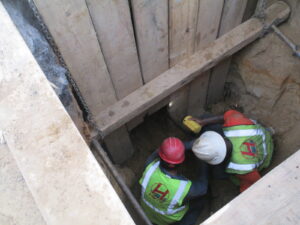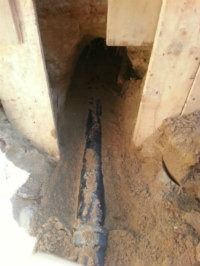Recently a sewer line repair was needed in Rosedale queens, the homeowner had been experiencing sewer backups resulting in a basement full of waste. The local plumber had been using a sewer line snake along with a water jet to clear roots from the sewer line every few months. As of recently the sewer line cleanings were becoming more frequent, the most recent jetting was within a two week span. The homeowner was no longer willing to take a risk of experiencing an all-out failure of her sewer line and decided to repair the pipe.
She was presented with two options; one was to replace the entire sewer line which is always suggested when dealing with clay pipe. The other option is to replace a 15’ section of the pipe where the roots were most heavily intruding the sewer line. Repairing a section of the clay sewer line is not recommended however, it is understandable when finances are factored along with the overall cost of replacing a sewer line.
The sewer line was originally going to be replaced in the roadway from the city sewer to the curb line, totaling 15’ of new extra heavy cast iron pipe. Harris begun digging in the roadway until they reached the sewer line which was approximately 11’ below street level. At this point the hole had to be properly shored with 14’ wooden planks as per DEP requirements. The Harris install crew now began removing the existing clay pipe when they encountered a great deal of roots in the sewer line.
Once they removed the existing pipe and roots they started to prepare for the new cast iron pipe installation when they noticed an abnormal amount of large roots in the sewer line. The roots were lodged in the sewer clogging the entire pipe, the crew spent the next three hours trying to remove the branch like roots when they realized that roots were lodged throughout the pipe all the way back to the property line.
How roots grow in a sewer line
Sewer lines are designed to remove waste from commercial and residential buildings however, backups occur quite often when the sewage encounters an obstruction from reaching the city sewer lines. The invasion of tree roots in a sewer line is the single most common factor a homeowner will encounter when facing a sewer line backup. If the infestation of tree roots is not treated in the early stages, they may force the need for a sewer line repair or replacement. Any crack, separation or opening in a sewer line serves as a tree roots paradise; small hair like roots will sense the warm water vapors and grow toward the pipe like metal towards a magnet. Once the root reaches the pipe it will look for any cracks or crevices as an entrance way. When the small roots enter the pipe it comes in contact with all of the essential nutrients needed to survive (minerals, oxygen & water) and may grow as large as the pipe itself in some cases.
What do roots in a sewer line mean for you?
If a pre-existing root issue is not tended to in the early stages of occurrence, it may result in the need for a sewer pipe replacement. Once roots have entered the pipe they obstruct the sewage from naturally flowing on gravity from the building to the city sewer. A homeowner should maintain the entire sewer line from the house to the city sewer as it is very common for tissues and grease to get caught in the roots resulting in complete failure of the sewer line. It is important to pay attention to how your sewer line runs in the yard prior to planting any trees. You can take precautionary measures in planting trees that are known to grow slowly and place them as far from the sewer line as possible.





















